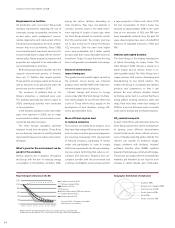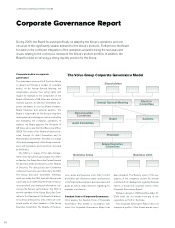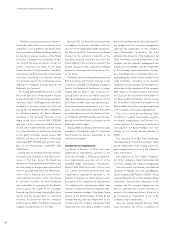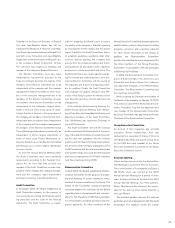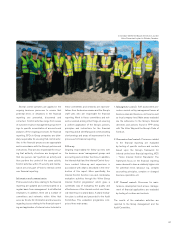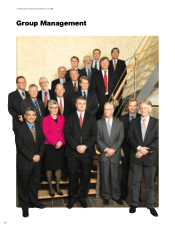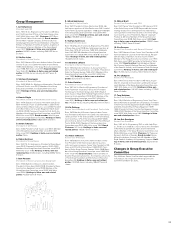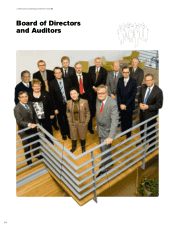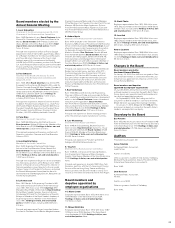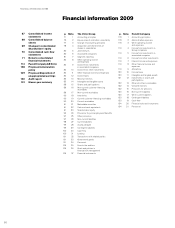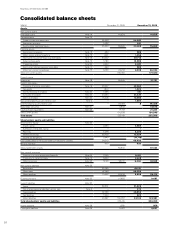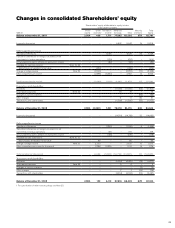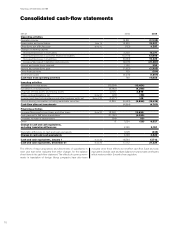Volvo 2009 Annual Report Download - page 64
Download and view the complete annual report
Please find page 64 of the 2009 Volvo annual report below. You can navigate through the pages in the report by either clicking on the pages listed below, or by using the keyword search tool below to find specific information within the annual report.
CORPORATE GOVERNANCE REPORT 2009
report for the period January 1 to June 30 and
the annual report. The auditors report their
ndings with regard to the annual report to the
shareholders through the audit report, which
they present to the Annual General Meeting. In
addition, the auditors report detailed ndings
from their reviews to the Audit Committee
twice a year and, once a year, to the full Board
of Directors.
When PwC is retained to provide services
other than the audit, it is done in accordance
with rules decided by the Audit Committee per-
taining to pre-approval of the nature of the serv-
ices and the fees.
Disclosure Committee
A Disclosure Committee was established in
2004. The Committee contributes to ensuring
that Volvo fullls its obligations according to
applicable legislation as well as to listing rules
to timely disclose to the nancial market all
share price sensitive information.
The Committee comprises the heads of the
departments Corporate Finance, Internal Audit,
Investor Relations, Corporate Legal, Business
Control and Financial Reporting. Chairman of
the Disclosure Committee is the company’s
Senior Vice President of Corporate Communi-
cations.
Outstanding share and share-price
related incentive programs
An account of outstanding share and share-
price related incentive programs is provided in
Note 34 Employees in the Group’s notes.
The Board’s report on the key aspects of
the company’s system for internal con-
trols and risk management regarding
financial reports
The Board is responsible for the internal con-
trols according to the Swedish Companies Act
and the Code. The purpose of this report is to
provide shareholders and other interested par-
ties an understanding of how internal control is
organized at Volvo with regard to nancial
reporting. The report has been prepared in
accordance with the Code and the guidance
issued by the Confederation of Swedish Enter-
prise and FAR SRS and is thus limited to in ternal
control over nancial reporting. This report is
included as a section in the Corporate Govern-
ance Report, but does not comprise a portion of
the formal annual report. This report has not been
reviewed by the company’s external auditors.
Introduction
Volvo primarily applies internal control principles
introduced by the Committee of Sponsoring
Organizations of the Treadway Commission
(COSO). The COSO principles consist of ve
interrelated components. The components are:
control environment, risk assessment, control
activities, information and communication and
follow-up.
Volvo has a specic function for internal con-
trol. The objective of the Internal Control func-
tion is to provide support for management
groups within business areas and business
units, that allows them to continuously provide
good and improved internal controls relating to
nancial reporting. Work that is conducted
through this function is based primarily on a
methodology, which aim is to ensure compli-
ance with directives and policies, as well as to
create good conditions for specic control
activities in key processes related to nancial
reporting. The Audit Committee is informed of
the result of the work performed by the Internal
Control function within Volvo with regard to
risks, control activities and follow-up on the
nancial reporting.
Volvo also has an Internal Audit function with
the primary task of independently verifying that
companies in the Group follow the principles
and rules that are stated in the Group’s dir-
ectives, policies and instructions for nancial
reporting. The head of the Internal Audit func-
tion reports directly to the CEO, the Group’s
CFO and the Audit Committee.
Control environment
Fundamental to Volvo’s control environment is
the business culture that is established within
the Group and in which managers and employ-
ees operate. Volvo works actively on communi-
cations and training regarding the company’s
basic values as described in The Volvo Way, an
internal document concerning Volvo’s business
culture, and the Group’s Code of Conduct, to
ensure that good morals, ethics and integrity
permeate the organization.
The foundation of the internal control pro-
cess relating to the nancial reporting is built up
around the Group’s directives, policies and
instructions, as well as the responsibility and
authority structure that has been adapted to the
Group’s organization to create and maintain a
satisfactory control environment. The principles
for internal controls and directives and policies
for the nancial reporting are contained in
Volvo Financial Policies & Procedures (FPP), an
in ternal book comprising all important instruc-
tions, rules and principles.
Risk assessment
Risks relating to the nancial reporting are eval-
uated and monitored by the Board through the
Audit Committee inter alia through identifying
what types of risks that typically could be con-
sidered as material and where they would typ-
ically occur. The annual evaluation of internal
control activities conducted by the Internal
Control and Internal Audit functions, are based
on a risk-based model. The evaluation of the risk
that errors will appear in the nancial reporting
is based on a number of criteria. Complex
accounting principles can, for example, mean
that the nancial reporting risks being inaccur-
ate for those posts that are covered by such
principles. Valuation of a particular asset or
liabil ity according to various evaluation criteria
can also constitute a risk. The same is true for
complex and/or changing business circum-
stances.
Control activities
In addition to the Board of AB Volvo and its
Audit Committee, the Boards and management
groups of Group companies constitute the over-
all supervisory body.
60






